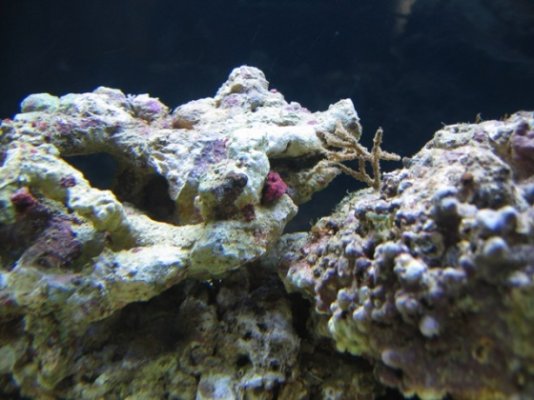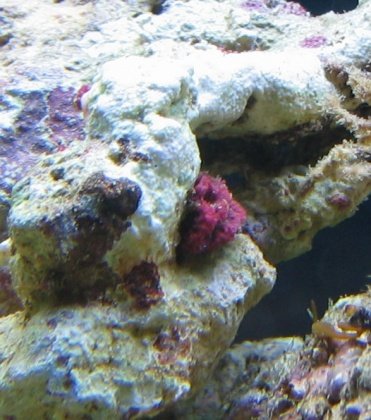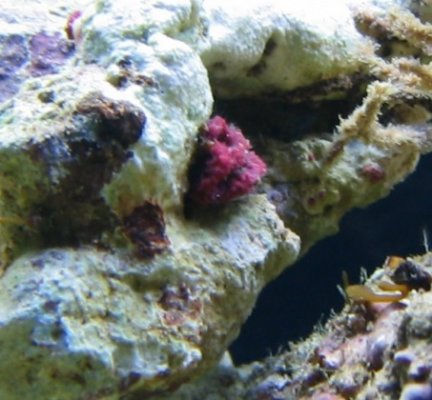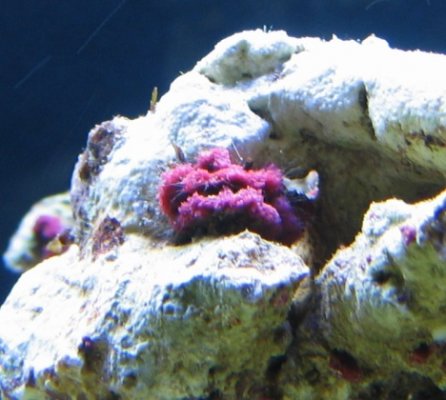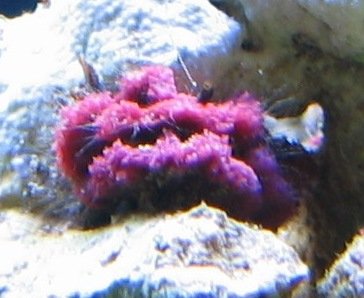You are using an out of date browser. It may not display this or other websites correctly.
You should upgrade or use an alternative browser.
You should upgrade or use an alternative browser.
Need another ID plz...
- Thread starter m3drver
- Start date
The friendliest place on the web for anyone with an interest in aquariums or fish keeping!
If you have answers, please help by responding to the unanswered posts.
If you have answers, please help by responding to the unanswered posts.
Kurt_Nelson
Aquarium Advice Addict
Can't really tell from the picture. It doesn't look bad to me. Almost looks like maybe some hitchiker LPS or something. Is this new rock, or has it been in your tank for a while?
m3drver
Aquarium Advice Activist
Sadielynn
Aquarium Advice Addict
- Joined
- Jul 6, 2006
- Messages
- 1,835
Looks like it could be a favia brain or a blasto .. Hard to tell from that angle , either way it is an LPS , they like mod light and will eat bits of mysis if you offer it when its feeding tenicals are out 
Kurt_Nelson
Aquarium Advice Addict
I'm leaning towards a blastomussa. See if it deflates a little when the lights go out. In addition to low to moderate light, they also like low flow. Nice rock!
m3drver
Aquarium Advice Activist
Sweet! There are two separate ones on that rock. pretty cool. I'll keep an eye on it but i haven't really noticed any change. its only about 3/4" to 1" long. actually both are about that size
Since my tank i still going through its cycle, should I be worried?
Mike
Since my tank i still going through its cycle, should I be worried?
Mike
Kurt_Nelson
Aquarium Advice Addict
...
Since my tank i still going through its cycle, should I be worried?
I wouldn't be worried, because cycling is something it has to do. You don't really get a say in it.
But I'd keep an eye on the ammonia levels and keep them from going too high - say 0.5 or maybe 1.0ppm or so. I'll let someone more experienced in that area give their recommendations though. If the ammonia or nitrite go too high, you probably will lose it (if it IS actually a LPS), so having some salt water premixed for partial water changes would probably be a good idea.
Welcome to AquariumAdvice!
m3drver
Aquarium Advice Activist
Kurt, thanks... looks like I'm on the right track. Ammonia as of yesterday was at .25 and I already have some fresh SW mixed up and ready for a PWC this weekend if the ammonia level skyrockets.
Thanks for the warm welcome!
Mike
Thanks for the warm welcome!
Mike
m3drver
Aquarium Advice Activist
I noticed something else with this... tonight I did a PWC and soon after I saw what looked like very thin "needle" like things coming off the edges. I did not notice it "deflates a little when the lights go out".
Also I repositioned the rock to get a better view as I did this I gently touched it. It seems to be hard but always looks like "velvet" and "looks soft" as my daughter would describe it.
Mike
Also I repositioned the rock to get a better view as I did this I gently touched it. It seems to be hard but always looks like "velvet" and "looks soft" as my daughter would describe it.
Mike
Kurt_Nelson
Aquarium Advice Addict
If the needle like things stayed attached to it, they almost sound like sweeper tentacles.
Odd though that it was hard when you touched it. Seems like if it was any type of LPS, it should've retracted or deflated when you touched it. Agree with your daughter... it does look like velvet!
Odd though that it was hard when you touched it. Seems like if it was any type of LPS, it should've retracted or deflated when you touched it. Agree with your daughter... it does look like velvet!
m3drver
Aquarium Advice Activist
Those "needle" things just seem to stay put. I can't seem to get a good pic of them since they are so thin.
anyway, I've been looking at this thing for the past few days. it looks like it is made up of 4 or 5 small "petals" or "leaves" kind of all bunched up to look like it was one solid structure.
I'm still lost as to what this is...
Mike
anyway, I've been looking at this thing for the past few days. it looks like it is made up of 4 or 5 small "petals" or "leaves" kind of all bunched up to look like it was one solid structure.
I'm still lost as to what this is...
Mike
Attachments
Sadielynn
Aquarium Advice Addict
- Joined
- Jul 6, 2006
- Messages
- 1,835
I am going with some sort of brain coral and what you are seeing are sweepers , some display them more often than others . If you brush by it does it sort of go flat ? I am a bit unsure of my ID since it is not a real close up photo . Pretty none the less 
Devilishturtles
Aquarium Advice Addict
Those little spikes, and the fact that it isn't moving at all when you touch it, makes me think it is a sponge. Sponges are composed of silica "spikes", which are probably pretty hard and sharp if you touch them. If that is the case, they are usually pretty easy to keep and feed mostly on particulate matter in the water.
HTH
HTH
m3drver
Aquarium Advice Activist
Those spikes can barley be seen in the pic. They don't seem to move with the water current which tells me they are somewhat stiff. the colored portion is definitely hard.
Can it be a sponge even though its hard to the touch? it doesn't react to me touching it either.
I know nothing about corals and by what everyone has posted ,if its a coral it should be soft or react when touched. which it doesn't.
Also in the tank is a small piece of the same thing that must have broken off when I was placing the rocks in the tank and now sits on the sand. It seems to me as this piece sometimes shifts it position. the water flow isn't moving it. its in an area of low flow. nothing is blowing around it. I just looks like those spikes, needle thingys or whatever, are causing it to shift its position. does that even make sense?
I've been staring at this thing for the past few days now. its driving me nuts.

Mike
Can it be a sponge even though its hard to the touch? it doesn't react to me touching it either.
I know nothing about corals and by what everyone has posted ,if its a coral it should be soft or react when touched. which it doesn't.
Also in the tank is a small piece of the same thing that must have broken off when I was placing the rocks in the tank and now sits on the sand. It seems to me as this piece sometimes shifts it position. the water flow isn't moving it. its in an area of low flow. nothing is blowing around it. I just looks like those spikes, needle thingys or whatever, are causing it to shift its position. does that even make sense?
I've been staring at this thing for the past few days now. its driving me nuts.
Mike
Attachments
Last edited:
m3drver
Aquarium Advice Activist
OK Folks, I think I finally have an ID on this. I've been searching for days now until I can across this article.
Foraminiferans by Ronald L. Shimek, Ph.D. - Reefkeeping.com
other folks have mentioned to me that it may be a sponge or a Foram. well I think i can now say it is a Foram. the article pretty much sums up all of my observations.
thanks everyone for your help.
Mike
Foraminiferans by Ronald L. Shimek, Ph.D. - Reefkeeping.com
other folks have mentioned to me that it may be a sponge or a Foram. well I think i can now say it is a Foram. the article pretty much sums up all of my observations.
thanks everyone for your help.
Mike
Kurt_Nelson
Aquarium Advice Addict
Wow. Learn something new everyday! Thanks for the link and info.
Wizzard~Of~Ozz
Aquarium Advice Addict
Is it hard or soft? if it's soft then it isn't a foram (also, the image in that article is 1/3" high, yours looks much larger). I'm doubting it's a foram test since they are calcareous and this looks soft.
In either case, let it grow and see what comes of it. post pics as it does.
In either case, let it grow and see what comes of it. post pics as it does.
Last edited:
m3drver
Aquarium Advice Activist
Its hard and about a 1/4 high and about 3/4 to an inch long. look at some of the other pics in my earlier posts.
this is the section of the article that lead me to believe its a foram test.
" They are large and obvious and are often exceptionally abundant. And, unlike the remainder of the forams discussed in this article, they are not found in the sediments. As they don't look like anything else in our systems, they are often misidentified as small sponges, hydrocorals or stony corals. These foraminiferans belong to a peculiar foram species called Homotrema rubrum and it has a shell that may be orange, but is more typically hot pink or bright cherry red. The red coloration is due to an iron salt that is incorporated into the skeleton. Found growing on hard surfaces such as rocks, the calcareous shell looks like a small hydrocoral or a hard, spiky crystal with angular projections. Homotrema seldom get larger than an eighth or quarter of an inch in height, but their brilliant color renders them very obvious. They feed on particulate material in the tank's water, probably mostly bacterial aggregates they catch in fine filamentous protoplasmic strands which extend from the tips of the angular projections. "
if it isn't a foram then do you have any suggestions as to what it can be? but I'm convinced it is since it matches with everything I've seen and felt.
Mike
this is the section of the article that lead me to believe its a foram test.
" They are large and obvious and are often exceptionally abundant. And, unlike the remainder of the forams discussed in this article, they are not found in the sediments. As they don't look like anything else in our systems, they are often misidentified as small sponges, hydrocorals or stony corals. These foraminiferans belong to a peculiar foram species called Homotrema rubrum and it has a shell that may be orange, but is more typically hot pink or bright cherry red. The red coloration is due to an iron salt that is incorporated into the skeleton. Found growing on hard surfaces such as rocks, the calcareous shell looks like a small hydrocoral or a hard, spiky crystal with angular projections. Homotrema seldom get larger than an eighth or quarter of an inch in height, but their brilliant color renders them very obvious. They feed on particulate material in the tank's water, probably mostly bacterial aggregates they catch in fine filamentous protoplasmic strands which extend from the tips of the angular projections. "
if it isn't a foram then do you have any suggestions as to what it can be? but I'm convinced it is since it matches with everything I've seen and felt.
Mike
Wizzard~Of~Ozz
Aquarium Advice Addict
You may be right, when looking at it the base doesn't look like something that I would associate with it, it looks a bit too much like a solid mass, rather then a structure (unless this is an illusion in this image, jpg cannot replace the resolution of our eyes). Altho it was the first thing that came to mind.
Keep an eye on it (I'm sure you would have anyway ) and post pics if it keeps growing.
) and post pics if it keeps growing.
Keep an eye on it (I'm sure you would have anyway
johnmaloney
Aquarium Advice Freak
- Joined
- Dec 21, 2007
- Messages
- 258
are you sure it is not a sponge?
Similar threads
- Replies
- 19
- Views
- 631
- Replies
- 3
- Views
- 532
- Replies
- 1
- Views
- 299

